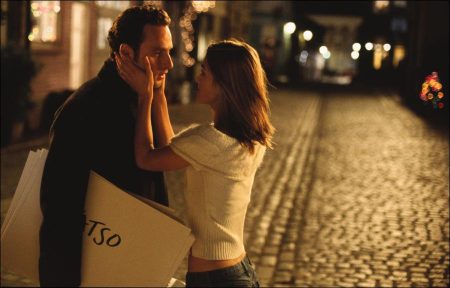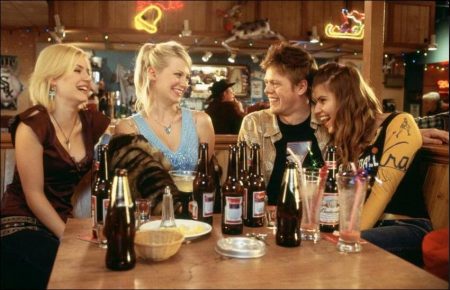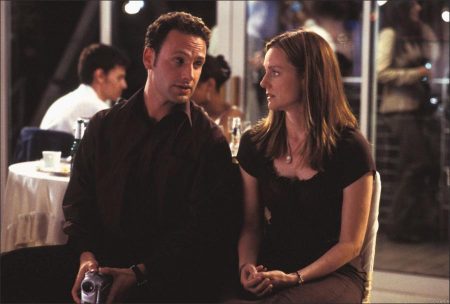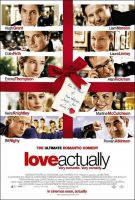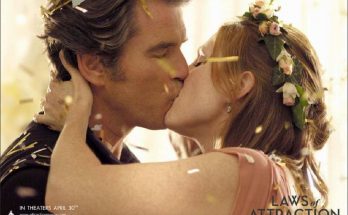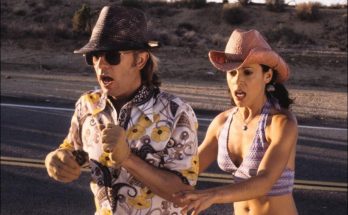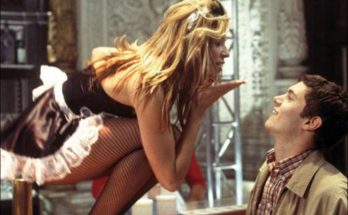Acclaimed screenwriter Richard Curtis (Four Weddings and a Funeral, Notting Hill, Bridget Jones’s Diary) now steps behind the camera for his directorial debut on his latest project, Love Actually—the ultimate romantic comedy that weaves together a spectacular number of love affairs into one amazing story.
Curtis is re-teamed with producers Duncan Kenworthy and Working Title’s Tim Bevan and Eric Fellner—the filmmakers responsible for some of the most popular looks at modern love in all its guises, including Four Weddings and a Funeral, Notting Hill and Bridget Jones’s Diary. The powerhouse cast brought together for this look at love and laughter also includes Rowan Atkinson, Andrew Lincoln, Martin Freeman, Kris Marshall, Thomas Sangster, Joanna Page, Lucia Moniz, Billy Bob Thornton and many others.
ove Actually is a 2003 British Christmas-themed romantic comedy film written and directed by Richard Curtis. The screenplay delves into different aspects of love as shown through ten separate stories involving a wide variety of individuals, many of whom are shown to be interlinked as their tales progress.
Set primarily in London, the story begins five weeks before Christmas and is played out in a weekly countdown until the holiday, followed by an epilogue that takes place one month later.
Film’s Genesis
It was while the group was working on another film (Richard writing, Duncan producing and Tim, Eric and Richard executive producing) about love and fame—Notting Hill—that the idea for Love Actually began to emerge.
Kenworthy remembers, “Richard usually gets the idea for his next film while he’s hanging around the set of his last one, so it was when we were working on Notting Hill that he was dreaming up Love Actually. He said he’d had an idea for something that would touch on lots of people’s lives. Richard had promised himself and the family that they would do something very special in the year 2000, and he and Emma and the kids went off to Bali for six months. Something ‘special’ for Richard was not working. And during his walks along the beach in Bali to exercise his damaged back, he was dreaming up ideas for this film.”
Richard says, “Love Actually is meant to be a real spoiling experience. I tried to work out the extra bits of plot and get straight from ‘A’ to ‘F.’ It’s like watching the edited highlights of several stories, yet put together, they all combine to an overall story—even though there are a lot of different ingredients, they form one cogent taste.”
Curtis’ story on the genesis of the project is less clear, but echoes Kenworthy’s take. He remarks with a smile, “I can’t remember how Love Actually started. I think it may be that I decided that films take me such a long time—about three years, in the end—and I thought that if I wanted to go on writing romantic films, I would spend the rest of my life doing it. So I decided that I would try to write nine or 10 of them all at the same time. I went away on a long holiday with my family and every day, during my walk, it was my job to come up with a story. I would think around the world that I knew, of little incidents from my past and the lives of people I knew, and slowly the storyline for Love Actually came to me.”
Tim Bevan observes, “Working Title has succeeded on the strength of the relationship we have built, and we’re proud of that. For us to have begun very early on with Richard and continued with him to this point—I can’t imagine a more satisfactory arrangement. The arrival of Love Actually was just a natural evolution, not only for Richard, but for us as well.”
Somewhere before / during / after the script for Love Actually began to emerge, the idea of Curtis directing the project also surfaced. “I said to Richard, at one point during Notting Hill,” says Kenworthy, “’You know, it’s either going to have to be you or me directing on the next one.’ I’m never surprised when a writer wants to direct his own work. It’s a genuinely difficult thing for a writer to hand over his work to a director to interpret. That’s why as a producer, I think of myself as the guardian of the script, making sure that everyone working on a film is working on the same film with the same interpretation of the script—because, generally speaking, the writer isn’t there.” Except on a Curtis film.
In addition to being a constant presence on the sets and in the editing rooms of his films, Curtis had also been, since 1987, co-producing the BBC’s live fundraising Comic Relief telecasts—all invaluable experience for the filmmaker about to launch into his directorial debut.
Kenworthy observes, “Richard’s always had the skills. Comic Relief is a fantastic training ground for working with actors. And he thinks in the round about everything—if the crew ask questions about whether a character wears glasses, where he would live, or what sort of pictures he would have on his wall, he’s always had those answers to hand.”
Curtis jokingly adds, “I think other directors were finding me hard to work with and I decided if anyone was going to suffer with me as an interfering writer, it might as well be me.”
About the Casting
All forces in filmmaking in their own right, the re-combination of Curtis, Kenworthy and Working Title’s Bevan and Fellner made for a dream situation when it came time to filling the roles of the seemingly multitudinous cast—the combined rolodexes alone could provide endless possibilities for casting choices.
Though several of the faces in Love Actually are longtime collaborators (including Grant, Thompson and others), many are new additions to the Curtis / Kenworthy / Working Title troupe. Kenworthy admits that while Curtis had specific actors in mind when penning selected parts, everyone was required to audition for the filmmakers.
“Richard definitely had certain actors in mind for certain roles this time, which had never happened before, not even on Notting Hill, but he still wanted to cast and cast and cast. One of the things we both learned from Mike Newell during Four Weddings is that you see everybody and you keep on looking and testing and casting up until the last minute, until you’ve got the perfect mix. That was all the more necessary with the balance of such a large cast in Love Actually,” tells Kenworthy.
The director/screenwriter offers, “Love Actually was a huge amount of fun to cast, because normally there aren’t enough roles to cast—if I have this actor then I can’t have that actor, that sort of thing. But in this film there are around 20 leading roles and everybody has a really substantial story to tell. So the casting process was a delight.
About the Locations
Curtis set Love Actually in the city he has called home (off and on) for the last two decades, London, but also includes jaunts to Marseilles (the airport, a restaurant, Aurelia’s house) and a villa in Vidauban, France (Jamie’s retreat)—a change for the writer/director (and a setting which underlines the difficulties facing the very British Jamie in such a very foreign place).
“Throughout my career, I’ve been proud of the fact that I’ve never had a day of filming outside of London—I’d never taken any of my characters outside the city and I thought I’d been very wise about that. But then after one week of filming in Marseilles, with gorgeous surroundings and lovely dinners, I realized that I had made a terrible, terrible mistake,” tosses Curtis. “Now, I’m never going to set anything closer to London than Morocco.”
Principal photography began on September 2, 2002 and continued for 13 weeks, with shooting on soundstages and on location in and around London (private residences, various businesses, a church, a chapel, Selfridges department store, a school, a boating base, the South Bank and even a racecourse building standing in for an American airport). Also, Curtis conceived of the opening and closing scenes happening in a place that truly demonstrates his point behind Love Actually—an arrivals hall at Heathrow Airport.
He remembers, “We were shooting a film in Los Angeles and I had to stand at the airport for about an hour waiting for a package. It was an extraordinary sight to see—these really ordinary faces of people looking bored while they waited suddenly exploding with all of this love and affection. You could see the complexity of their relationships right there in their faces, and that’s the kind of truth I’m trying to show.”
Curtis closes, “I’m very haunted by what constitutes being ‘realistic’—if I had to say, to me The Sound of Music seems to be quite a realistic piece of work. That film, which is accused of being totally saccharine, says two things: that good people hated the Nazis, which they did; and that lots of people fall in love and love their children, which they do. So there seems to me to be more truth to that than something that’s called a searingly realistic drama, because all over the world, every minute of every day, people are falling in love. I say that no matter how dark the world gets, the actual texture has a lot to do with love.”
Love Actually (2003)
Directed by: Richard Curtis
Starring: Liam Neeson, Laura Linney, Hugh Grant, Emma Thompson, Colin Firth, Martine McCutcheon, Bill Nighy, Keira Knightley, Joanna Page, Heike Makatsch, Andrew Lincoln
Screenplay by: Richard Curtis
Production Design by: Jim Clay
Cinematography by: Michael Coulter
Film Editing by: Nick Moore
Costume Design by: Joanna Johnston
Set Decoration by: Caroline Smith
Music by: Craig Armstrong
MPAA Rating: R for sexuality, nudity, language.
Distributed by: Universal Pictures
Release Date: November 7, 2003
Visits: 47
